Food for Thought: Identifying Food Sources and Habitat for Game Animals
2/25/2019 8:20:20 AM
By John Gruchy and Lann Wilf
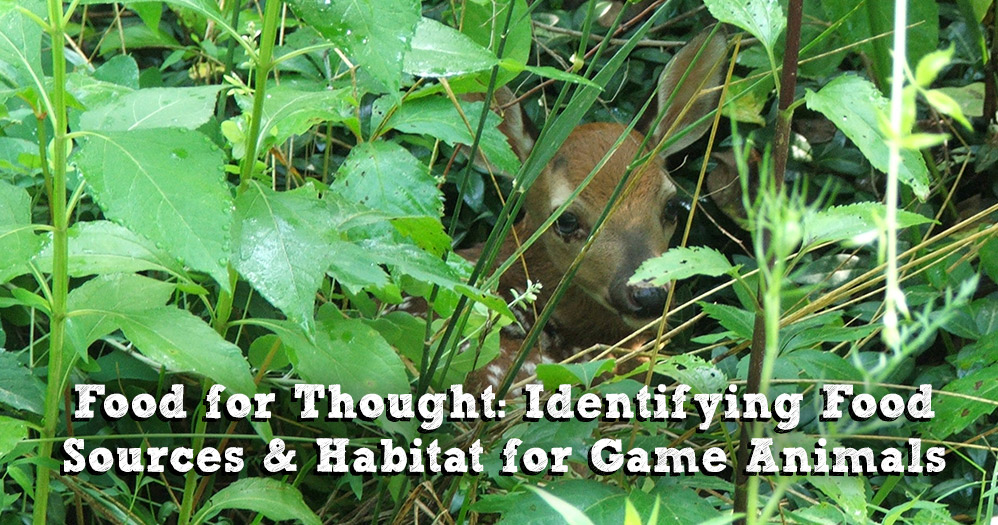
Few tasks are more challenging than coercing a picky child into swallowing a mouthful of green vegetables. Children from all walks of life often have great difficulty understanding why they cannot sustain themselves on pizza and soft drinks alone. Children rarely have an appreciation for the merits of a balanced diet, and it is often a struggle for many parents to get their kids to eat a variety of quality foods. Just as our children cannot live on junk food alone, deer, turkeys, waterfowl, and small game tend to thrive when a diverse array of food items are available in the forests and fields in which they inhabit. A good knowledge of natural foods for game animals can greatly improve one’s ability to assess and manage a property for good wildlife habitat.
The first step in learning more about what game animals commonly eat is to establish a working knowledge of natural foods such as wildflowers, grasses, trees, shrubs, vines, and other food items. There are literally tens of thousands of plants in Mississippi. It would be nearly impossible for one person to learn each and every plant. Fortunately, that extensive level of effort is not needed. A more realistic goal would be to develop the ability to group plants in broad categories. Other helpful information to take note of in identifying plants includes the site where the plant occurs (e.g., wetland, dry upland, forest, field, etc.), the time of year that the plant is actively growing (e.g., warm-season or the cool-season), and whether or not the plant is an annual or perennial (e.g., annual plants live for only one growing season, and perennial plants often live multiple growing seasons).
It is also important to understand the value of certain plants to specific wildlife species. For instance, although annual grasses like wild millet tend to provide poor forage for white-tailed deer, they offer very important, high-energy seeds for waterfowl and bobwhite quail. Furthermore, some plants may not be commonly eaten, but provide important cover or attract insects, which are a critical food for turkey and bobwhite hens during nesting. Learning field and forest plants and their value to wildlife can be a daunting task, but it is well worth the effort.
Forbs – green forage, seed production, and cover
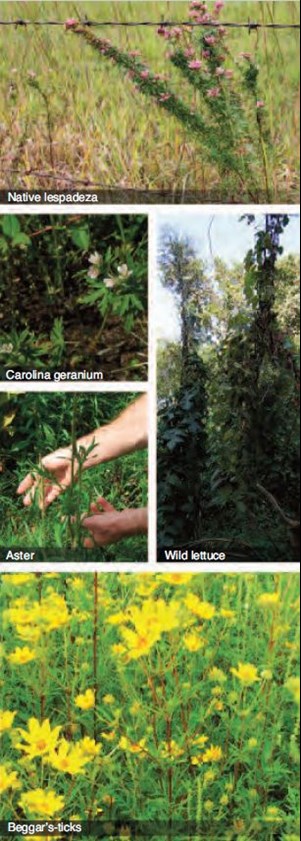 For the purposes of this discussion, the first broad group of plants to identify are broad-leaf herbaceous plants called forbs. Forbs may be annual or perennial plants, and some examples of native forbs are common wildflowers such as black-eyed Suzan, butterfly milkweed, and even notorious pollen producers such as goldenrod and ragweed. Many forbs provide important green forage for deer, rabbits, and even wild turkeys, while some, like native lespedezas, produce seeds and cover that are important foods for bobwhites, turkeys, small mammals, and songbirds. Many supplemental forages commonly planted in deer food plots, such as clovers, cowpeas, and chicory, are forbs. In fact, as much as 70% of a deer’s spring and summer diet consists of forbs. Some native forbs commonly eaten by deer during summer include ragweed, sumpweed, wild lettuce, pokeweed, verbena, beggar’s lice, partridge peas, and asters. Forbs tend to become dormant and largely unavailable during the winter, but early spring forbs such as Carolina geranium and vetch can be important sources of protein before other plants begin to grow. Many native forbs will rival any commercial, supplemental forage with regards to crude protein content and digestibility, with some having crude protein contents above 30%.
For the purposes of this discussion, the first broad group of plants to identify are broad-leaf herbaceous plants called forbs. Forbs may be annual or perennial plants, and some examples of native forbs are common wildflowers such as black-eyed Suzan, butterfly milkweed, and even notorious pollen producers such as goldenrod and ragweed. Many forbs provide important green forage for deer, rabbits, and even wild turkeys, while some, like native lespedezas, produce seeds and cover that are important foods for bobwhites, turkeys, small mammals, and songbirds. Many supplemental forages commonly planted in deer food plots, such as clovers, cowpeas, and chicory, are forbs. In fact, as much as 70% of a deer’s spring and summer diet consists of forbs. Some native forbs commonly eaten by deer during summer include ragweed, sumpweed, wild lettuce, pokeweed, verbena, beggar’s lice, partridge peas, and asters. Forbs tend to become dormant and largely unavailable during the winter, but early spring forbs such as Carolina geranium and vetch can be important sources of protein before other plants begin to grow. Many native forbs will rival any commercial, supplemental forage with regards to crude protein content and digestibility, with some having crude protein contents above 30%.
Forbs are also important for the cover that they provide, which is vital to successful fawning and brood-rearing. The growth habit of many forbs, such as ragweed, tends to be less dense near the ground with a canopy that is a few inches above the ground. This “umbrella cover” creates tunnels or openings at ground level, which allows young bobwhite and turkey broods to move about obscured from predators to for-age. This type of cover is also ideal for newborn fawns to loaf in while the mother is feeding between nursing events. The ability for small wildlife to move about easily while being protected from above is a luxury not afforded by rank vegetation in many unmanaged fields and pastures. Forbs are also an important substrate for insects, especially in the case of waterfowl, where plants like annual smartweeds hold insects and other invertebrates that provide protein, which is crucial for hens returning to nesting grounds in good body condition.
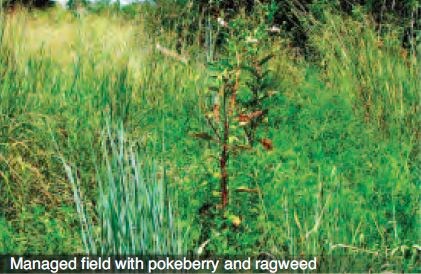
Mast – good while it lasts
Mast is simply the fruit of trees and woody shrubs. Generally, mast is divided into hard mast (e.g., acorns, hickory and beech nuts, etc.) and soft mast (e.g., persimmons, crabapples, American beautyberry, blackberries, etc.). As many hunters are aware, acorns are a very important food sources for all game animals. However, hard mast is more than just oak acorns. Black walnuts and hickory nuts provide important, early food sources for squirrels. The cuttings squirrels leave while eating these nuts become available for bobwhites and other wildlife as well. American beech and chinquapin are less common examples of hard mast that are important where they are available.
Many hunters recognize the value of hard mast to wildlife during the winter season, but they often overlook the importance of soft mast at other times of the year. Soft mast producers, like red mulberry and blackberry, provide important carbohydrates during the summer. Most soft mast producing trees (e.g., pawpaw, black cherry, Carolina buckthorn, black tupelo, dogwood, sugarberry, etc.) tend to drop their fruits in late summer, which is a nutritionally stressful period for deer because does are lactating and bucks are growing antlers. This timing of fruit production is also important because much of the high-preference woody browse and forbs have become course and less desirable. Soft mast-producing shrubs like elderberry, huckleberry, and sumac can also provide important food and cover. Like hard mast, soft mast production can be highly variable based on precipitation, insect cycles, pollen conditions, and other factors. Soft mast staples for deer in Mississippi tend to include persimmon, Chicka-saw plum, crabapple, American beautyberry, and elderberry where they are available.
It is important to note that acorns and other mast are only available for a brief period during the year, and production is often highly variable from year to year. It would be a great error to assume that a property provides all food resources that deer or other game animals need simply because it contains oaks or other mast bearing trees and shrubs. Management of fields and forests to provide a variety of herbaceous plants is critical to proper habitat management, regardless of the availability of hard mast.
Woody browse, shrubs, and vines – what makes a deer
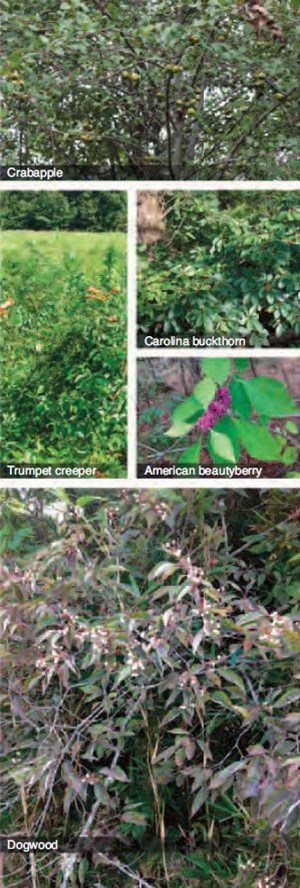 The difference between deer and many other hooved mammals is that deer are primarily adapted to eat browse (the foliage and green twigs of woody plants), while many other hooved animals eat mostly grass. Grass takes more sunlight and moisture to grow than woody browse and is less common in forested settings. The ability to selectively consume a more diverse, yet higher-quality diet gives deer a competitive advantage.
The difference between deer and many other hooved mammals is that deer are primarily adapted to eat browse (the foliage and green twigs of woody plants), while many other hooved animals eat mostly grass. Grass takes more sunlight and moisture to grow than woody browse and is less common in forested settings. The ability to selectively consume a more diverse, yet higher-quality diet gives deer a competitive advantage.
Nutrition and digestibility of natural browse plants varies greatly by plant species, time of year, portion of the plant consumed, and soil regions in which they are found. Woody plants tend to be more succulent and provide greater nutrition when their shoots are young and fresh. By late summer, much of the woody browse becomes course, creating a potential nutritionally stressful period that should be addressed through habitat management.
Commonly eaten woody browse includes the young growth of black tupelo, red maple, green ash, dogwood, osage orange, and devil’s walking-stick. High preference shrubs include strawberry bush, American beautyberry, elderberry, and wild huckleberries. Vines such as most greenbrier species, dewberry, poison ivy, rattan vine, and trumpet creeper are considered high preference browse as well. On many properties in Mississippi, high preference browse pants are heavily utilized or nonexistent in mid-to-late-summer.
Browse preference is often highly variable and may be difficult to assess; however, there are a few plants that tend to be low-preference forages. These plants can be indicators of local deer herd health. If low-preference deer forages are used heavily, it is likely a symptom of deer overabundance and low availability of quality browse. Examples of low-preference deer forages include many wild grape species (e.g., muscadines), pepper vine, Eastern red cedar, pines, hog peanut, and sweetgum. Learning to recognize a few browse plants and understanding deer browse preference help gauge browse pressure and evaluate herd condition.
Grasses – seed production and cover…but not forage
Managed native grasses can provide outstanding cover for deer, turkey, bobwhites, and other upland wildlife in fields and open-canopy forests. It is true that native, warm-season grasses like bluestem and switchgrass have been given considerable attention lately for the cover that they provide. But make no mistake, they are not food for anything but cattle. In fact, deer rarely forage on grass at all, apart from cultivated cereal grains, such as wheat and oats.
For other wildlife species, however, annual grasses (e.g., wild millets, sprangletop, and panic grasses) are a key food source for wintering waterfowl. Bobwhites, turkeys, doves, and small mammals tend to use seeds from annual grasses while perennial grasses are used less widely. Most importantly, annual and perennial grasses provide critical nesting substrate for bobwhites, rabbits, and other wildlife. It is also important to note that grasses are important fuel in areas where prescribed fire is an intended management practice.
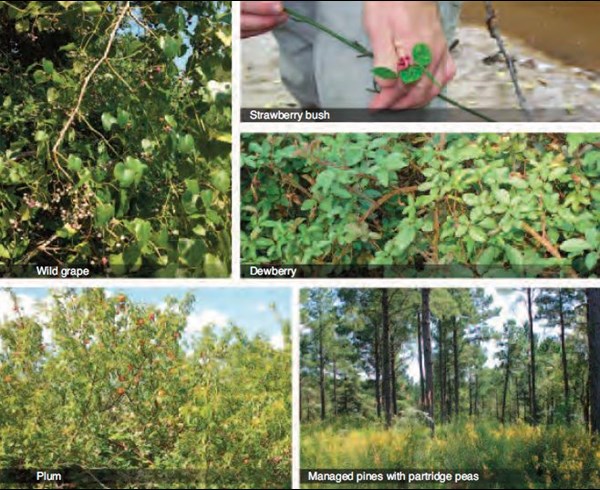
Putting it all together – manage for diversity
As evident from the discussion above, the diets of game animals are highly diverse. If your goal is to produce food for game animals beyond supplemental food plots, then diversity of quality forages needs to be a management objective. Management of fields and forests is essential in providing plant diversity that meet nutritional and cover needs of wildlife throughout the year. Do not expect wildlife to flourish if all they have to eat is pizza and soft drinks.
For more information about managing habitat and wildlife, contact the Mississippi Department of Wildlife, Fisheries, and Parks at (601) 432–2199 or visit www.mdwfp.com.
John Gruchy is the Private Lands Habitat Program Coordinator at MDWFP. Lann Wilf was a former MDWFP Deer Program Leader.









